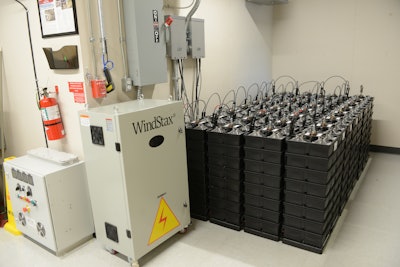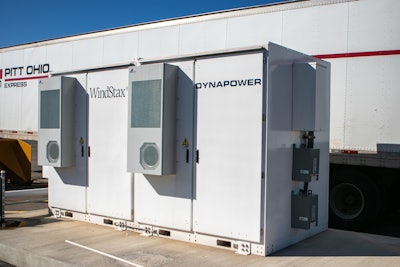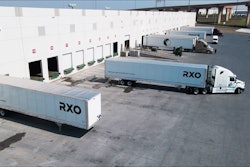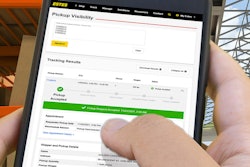
CCJ Innovators profiles carriers and fleets that have found innovative ways to overcome trucking’s challenges. If you know a carrier that has displayed innovation, contact CCJ Chief Editor Jason Cannon at [email protected] or 800-633-5953.
The arguments and myths against zero emission trucking are plentiful, especially as it relates to the generation of grid-based electricity, which itself can be an unclean process.
Pittsburg, Pennsylvania-based PITT OHIO in March became the first fleet in the country to add Freightliner's electric M2 to its Cleveland, Ohio-based LTL business, but going green at the tail pipe wasn't green enough. PITT OHIO’s Cleveland terminal is also home to a patented renewable energy microgrid that is powered by eight wind turbines and 1,500 solar panels.
"Wind and solar and alternative energy are part of our culture," said Director of Building Maintenance and Property Management Jim Maug, "but the big picture items: post-consumer recycled material, biodegradable cleaning products, recycling, no off gas and no [volatile organic compounds] in our paint, LED lighting, low water usage... these are all big picture items that make the entire package."
Among the newest parts of the package – if not the most technologically sophisticated – is a renewable energy powered microgrid found at two of PITT OHIO's terminals, each taking wind and solar energy and distributing that power to points of use. The motor carrier received the patent for this process in 2020. While certainly a step in the motor carrier's decarbonization plans, Maug said originally it was a way to insulate the business from potential power outages.
 PITT OHIO partnered with WindStax Energy to design and install a ZeroFirst high voltage DC microgrid using solar and wind turbines to generate, store, and consume renewable energy on-site.
PITT OHIO partnered with WindStax Energy to design and install a ZeroFirst high voltage DC microgrid using solar and wind turbines to generate, store, and consume renewable energy on-site.
The idea for renewable energy began in 2012 with solar installation at the company’s East Windsor, New Jersey, terminal.
PITT OHIO then began talking with The University of Pittsburgh’s Swanson School of Engineering to study direct current (DC) energy by way of solar panels and wind turbines, and eventually built a laboratory for the school inside its Pittsburgh terminal where research students could study the terminals’ wind turbine and solar panel activity.
PITT OHIO partnered with WindStax Energy to design and install a ZeroFirst high voltage DC microgrid using solar and wind turbines to generate, store, and consume renewable energy on-site. Excess renewable energy is sent back to the utility when generation exceeds demand – a model that strikes a balance between self-consumption and net metering to reduce the facilities' annual carbon footprint.
Justine Russo, PITT OHIO's director of sustainability & business intelligence, noted that generally speaking, the only things not using the power generated by the carrier at the Cleveland site are the company's electric trucks.
"The goal was to connect the microgrid to the fast chargers so we could charge an electric truck strictly off of renewables," she said, "The trucks just take too much power."
The Cleveland microgrid combines solar and wind energy with battery storage to power lighting loads throughout the facility. Awarded several U.S. patents, the high voltage direct current distribution-to-the-fixture design uses renewable energy with maximum efficiency.
However, the wind doesn't always blow, the sun doesn't always shine, and temperature swings and weather anomalies can have a major influence of power consumption and generation, so utility power is available seamlessly as a backup. Any excess renewable energy generated by PITT OHIO is sent into the grid.
"Sometimes in the summertime you make more power than you use and you give back to the grid. In the wintertime, sometimes, you'll make less," Maug said, adding that over the course of a 12-month year, the facility is essentially net zero. "How it works is you use what you make. Some days, rainy overcast days, you don't make as much. And then in August you make a whole lot."
Ohio is among the top 10 states in total energy consumption, according to the U.S. Energy Information Administration, yet renewable energy resources supplied about 4% of Ohio's total in-state electricity generation in 2022. Because in-state generation does not meet consumer demand, Ohio typically imports 20%-25% of its electricity from other states and Canada by way of the regional grid.
The PITT OHIO system runs first on power generated on-site before sapping any needed balance from the grid – WindStax Energy's "ZeroFirst" system. Any surplus sent to the grid acts like a credit with the power company when it bills based on the facility's consumption. "There's a meter that says, 'We gave X, and before you charge us for anything, we use X,'" Maug said.
Russo noted that the company's microgird likely won't make sense in each of the company's 25 facilities, adding their approach has been "to find the right opportunities in the right locations. We have over 1,000 power units at 25 facilities. That's a lot of diesel to replace. I think it's more where does it make sense to put in new technology?"
Maug added the company has installed numerous weather stations across its network to help provide data on where similar renewable systems might work. "We will go through our terminals site by site to see which ones would benefit most," he said. "I think that there's a risk to going 100% self-generated. I think there's a risk with staying 100% on the grid. I think we are very forward thinking, but also incremental in our approach, and we'll continue to do that."
Just as the East Windsor installation gave rise to a larger and more capable system in Ohio, Maug expects advancements in technology to continue to expand the potential of PITT OHIO's microgrid system.
"What we did in East Windsor was what was available at the time," he said, "and taking it another step as technology had matured, we went with the microgrid. I can tell you this will mature even further."
That maturation process, Maug said, would have to involve jointly a lot of stakeholders, trucking and otherwise.
"What we've been through, this is gonna have to be a community-based environment. No one company will be able to solve it. It'll need to be a whole bunch of companies working with the government. There will need to be more efficient sources of charging – and I really don't know if that's going to be hydrogen in the future, if that's nuclear, if that's co-generation in the future... This will have to be many communities and governmental authorities getting together to solve the problem. These are giant amounts of energy that have to be produced and the charging stations have to be similar."
The CCJ Innovators program is brought to you by Bestpass, Chevron Delo, Comdata and Freightliner Trucks.













